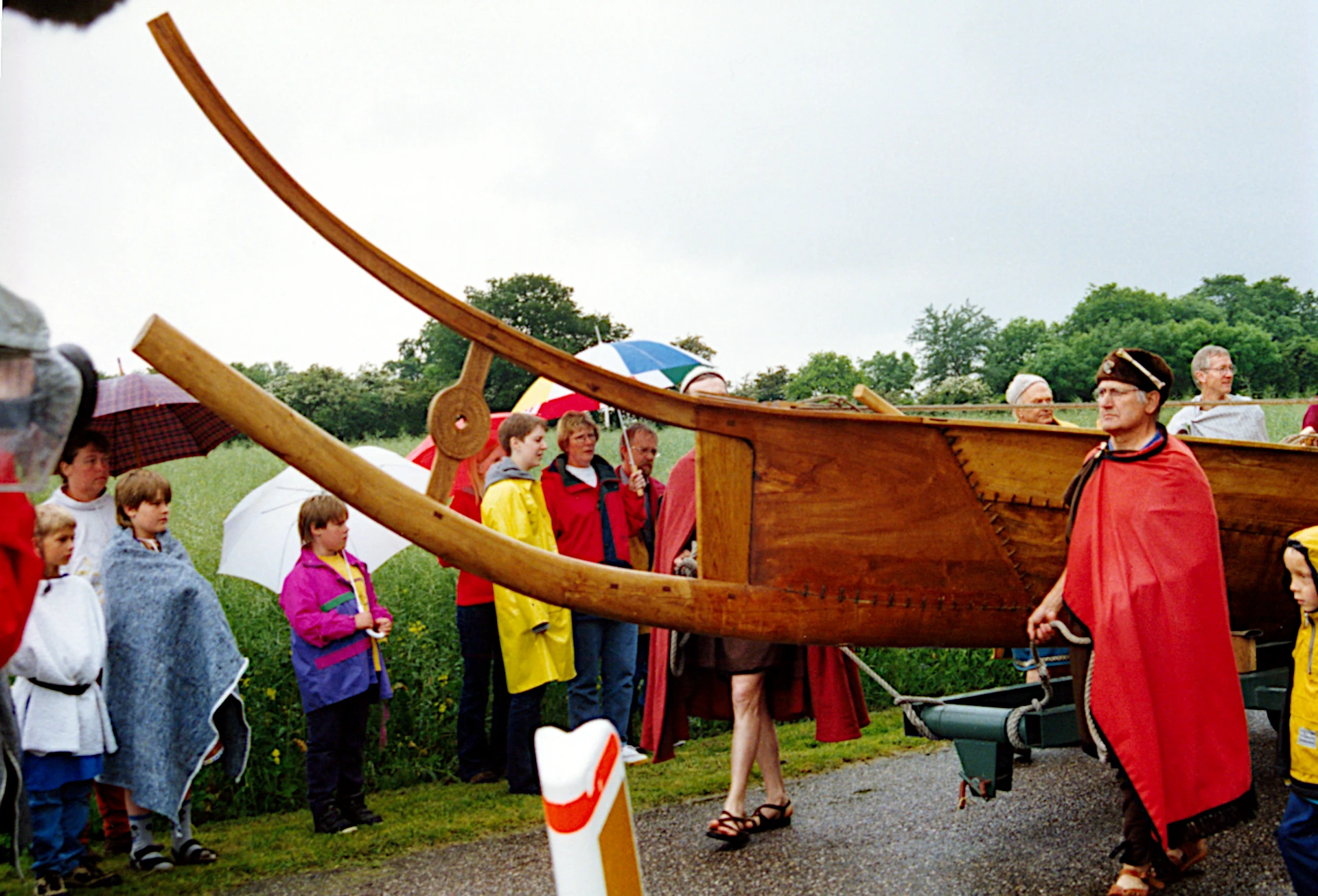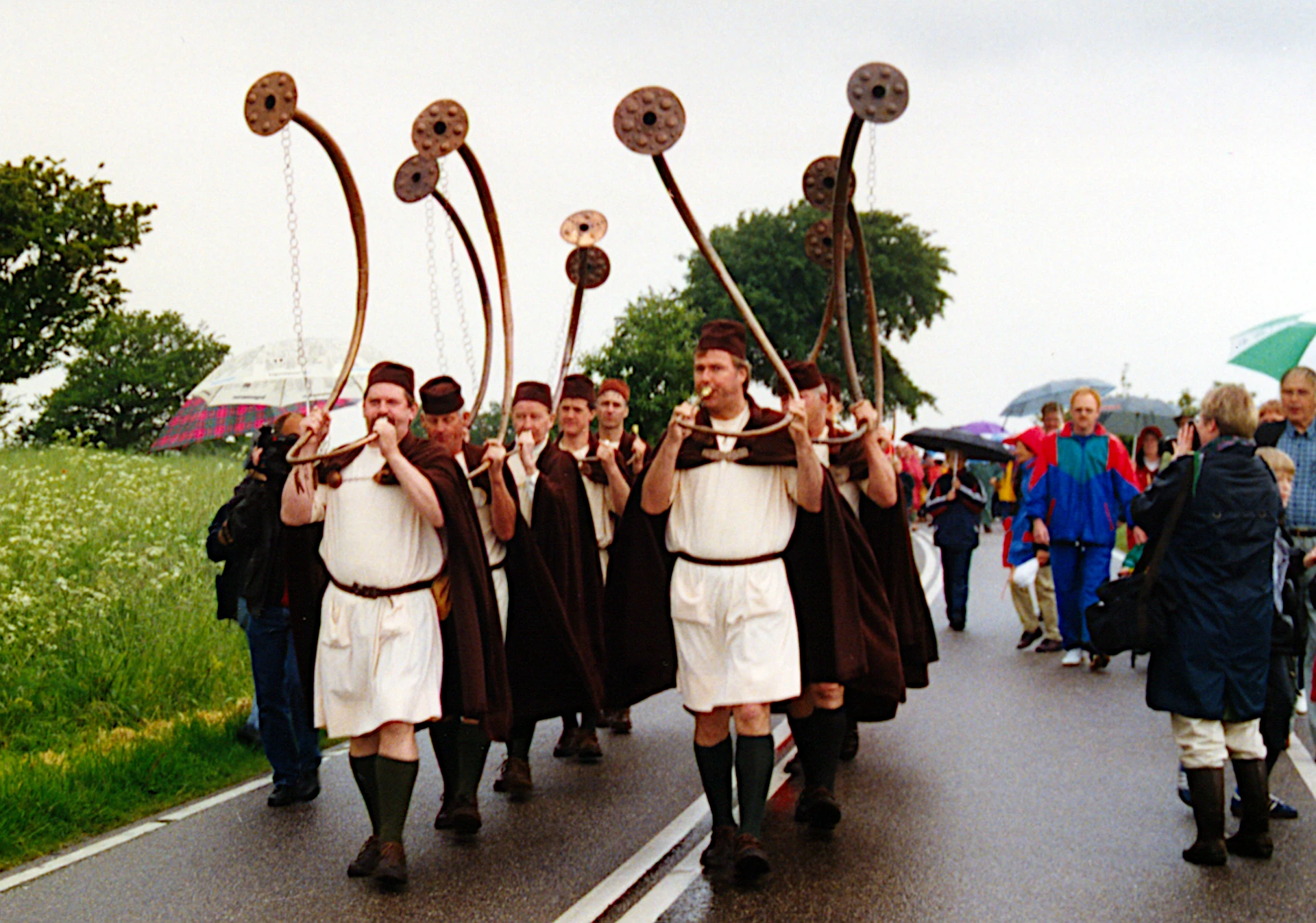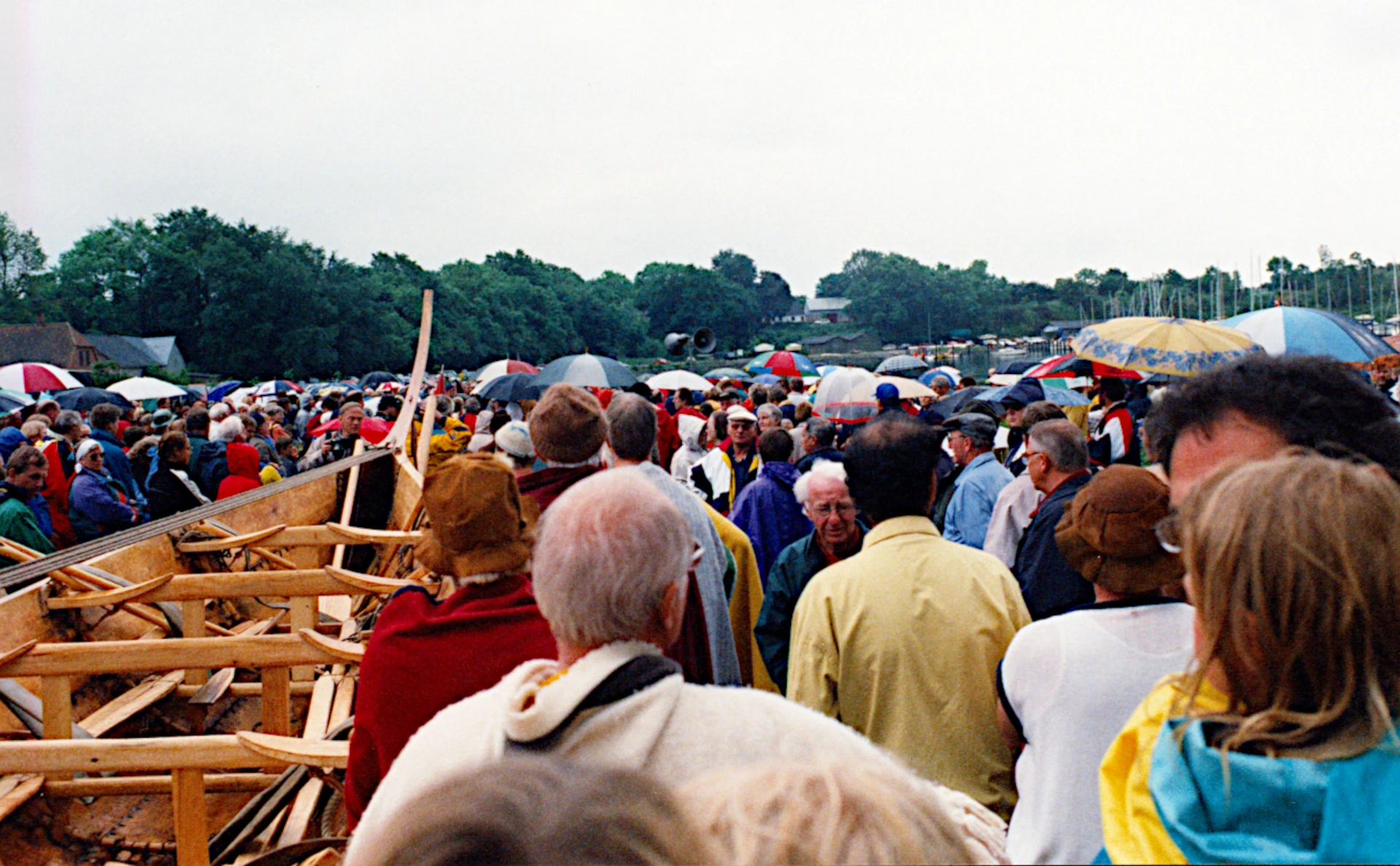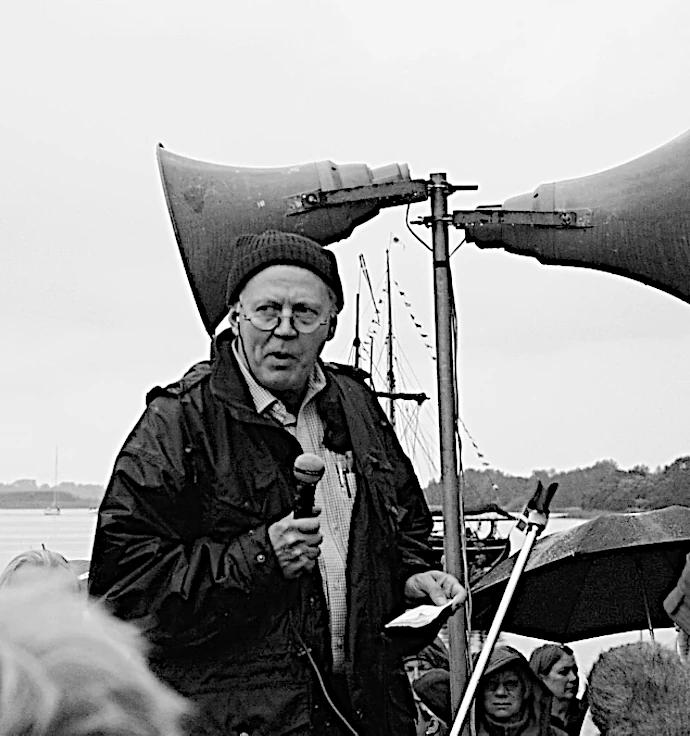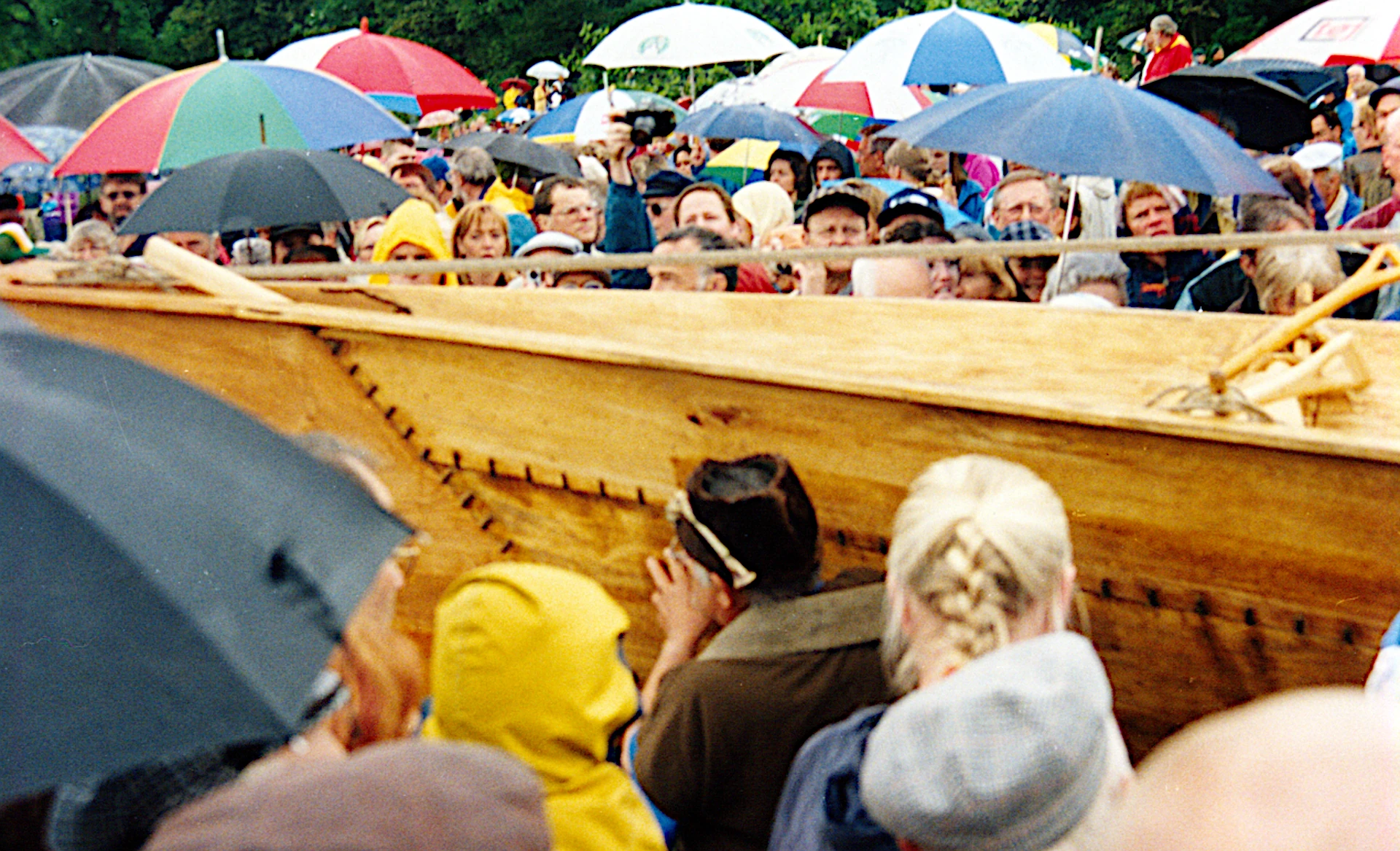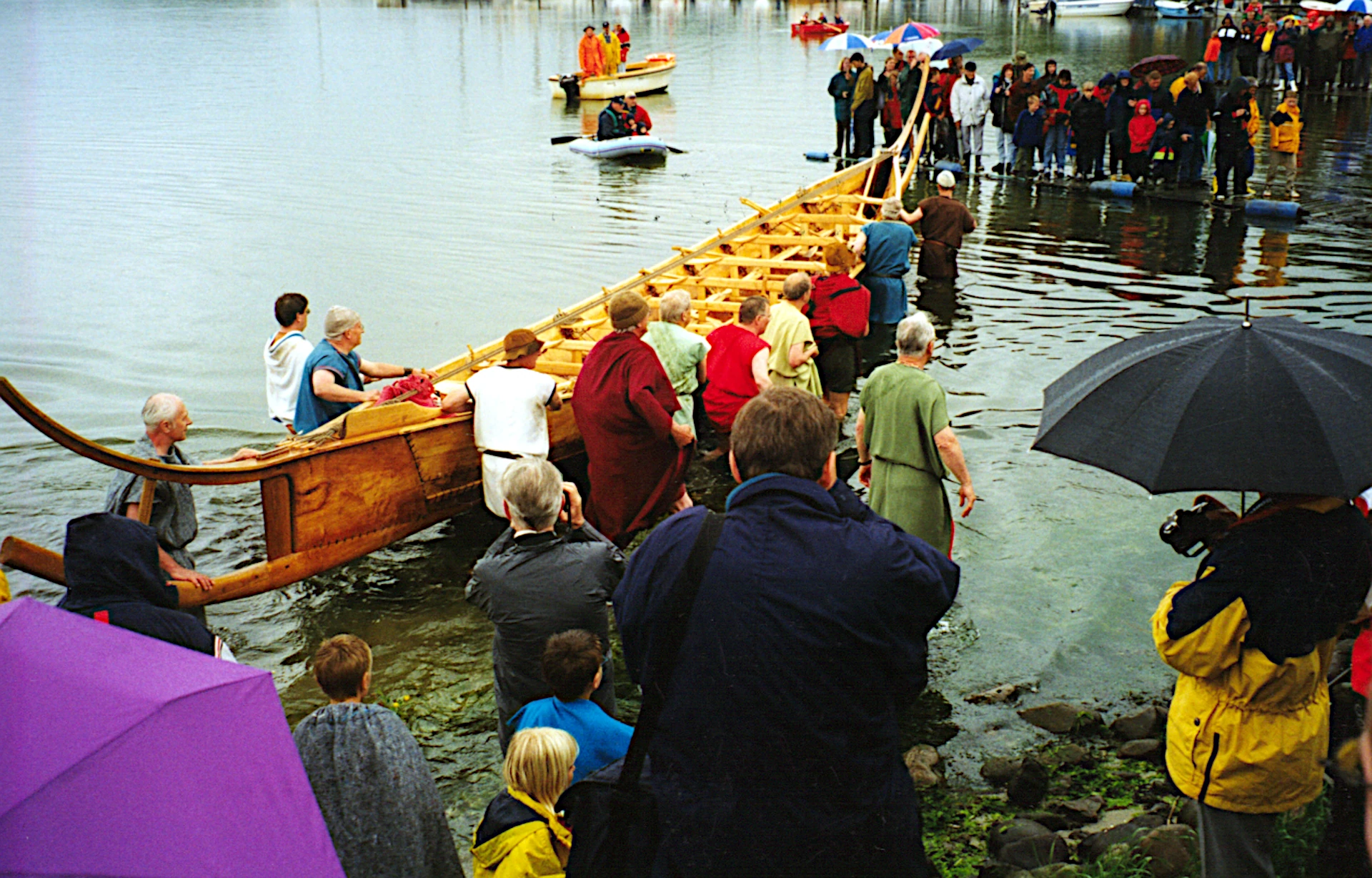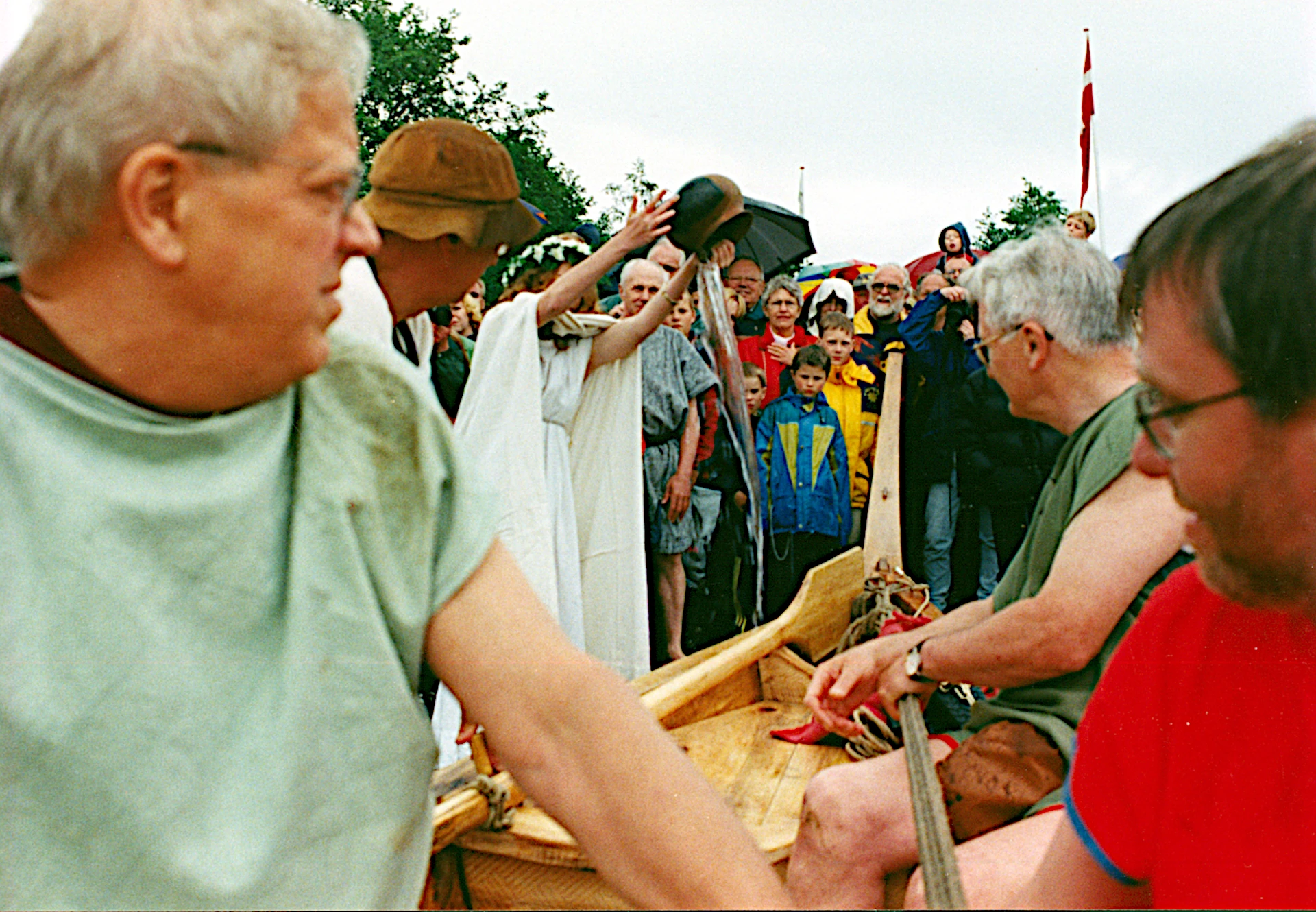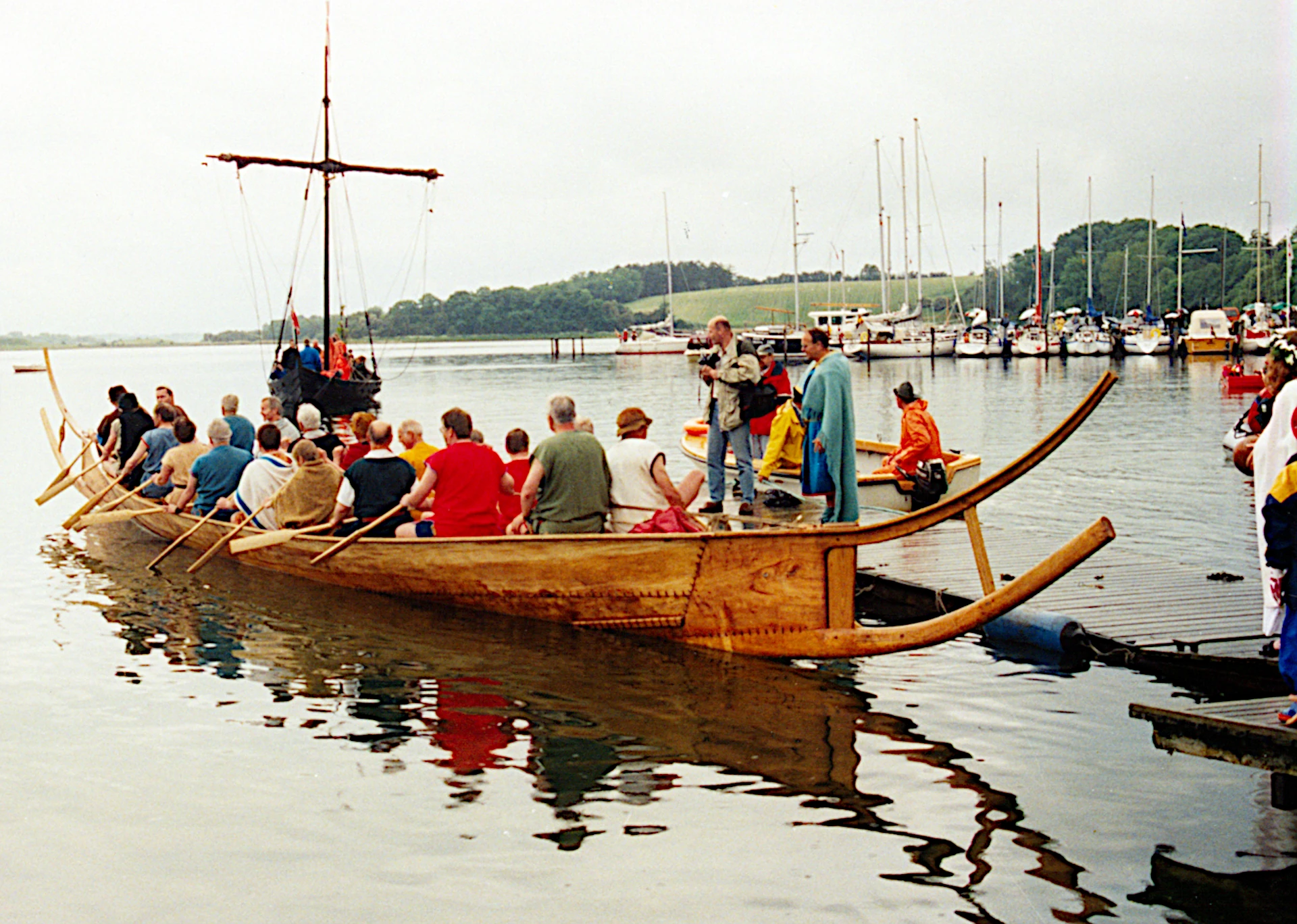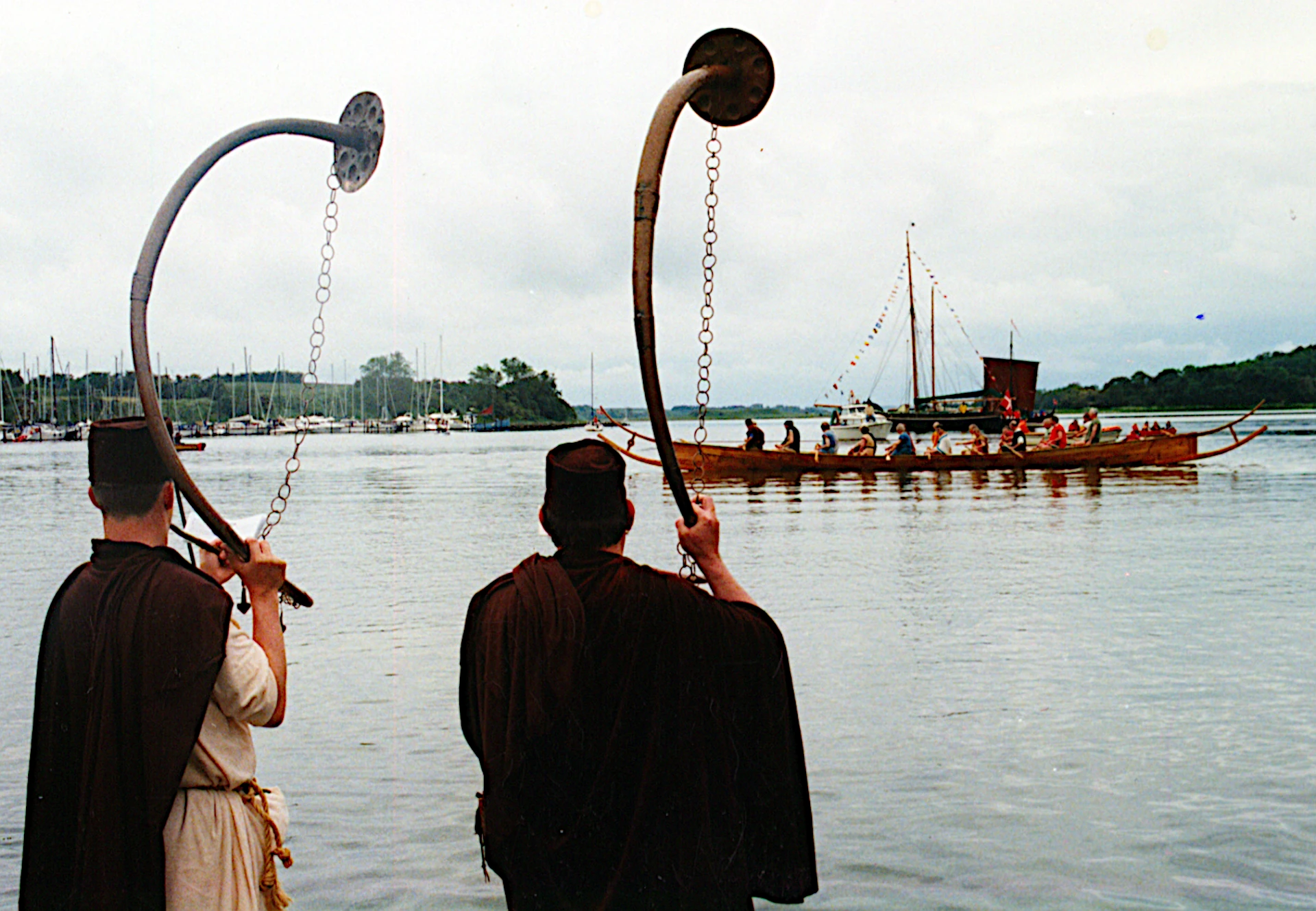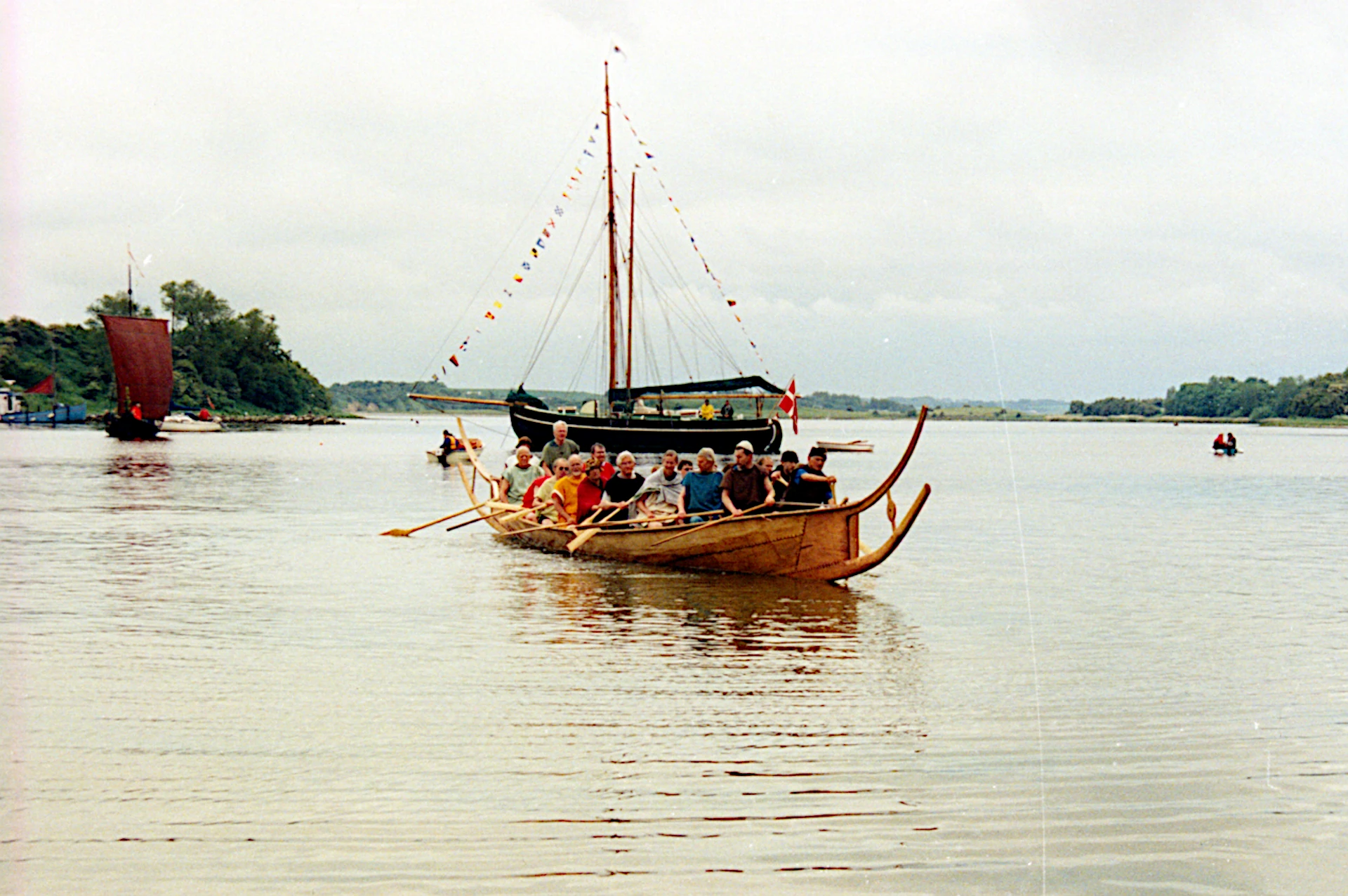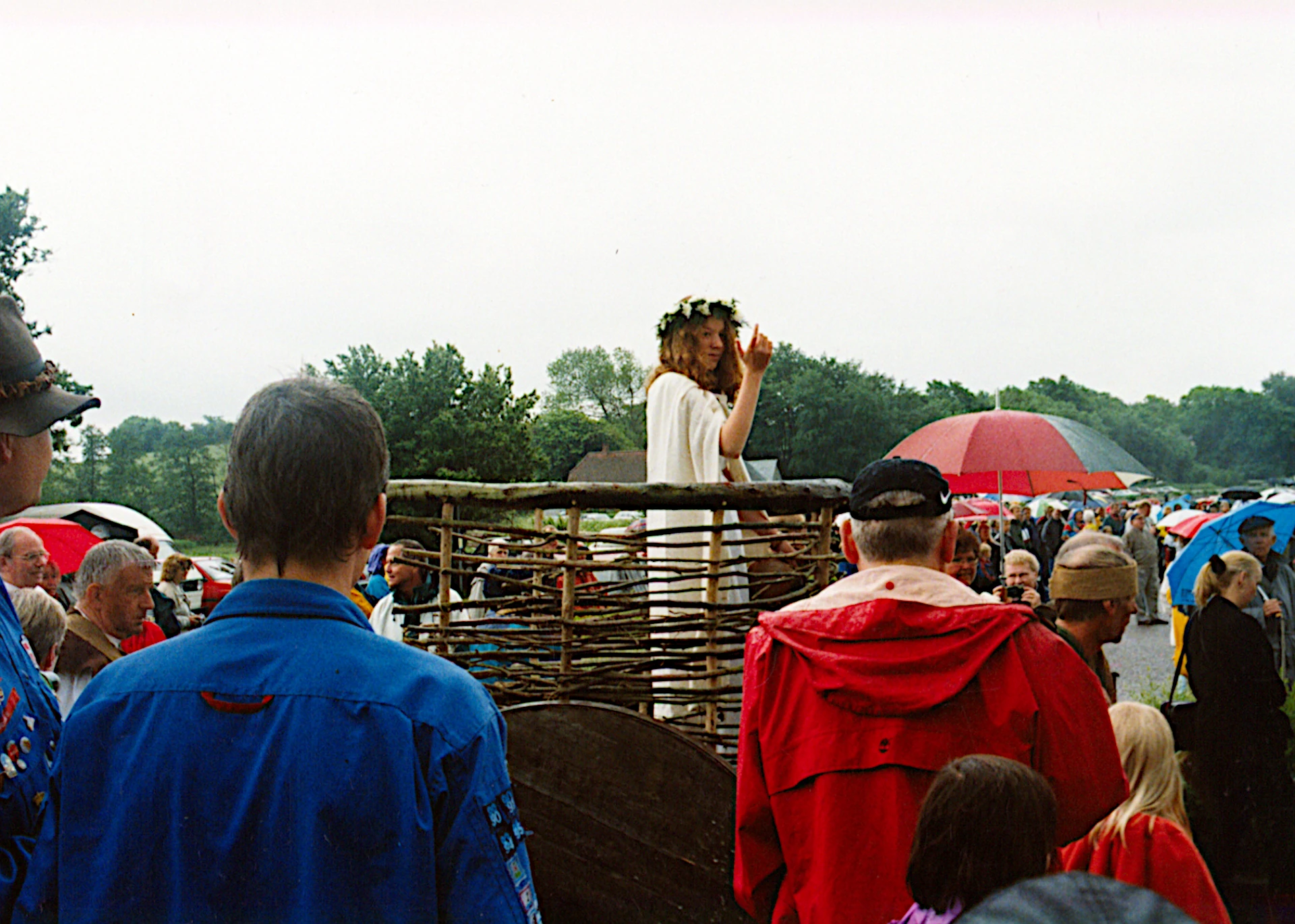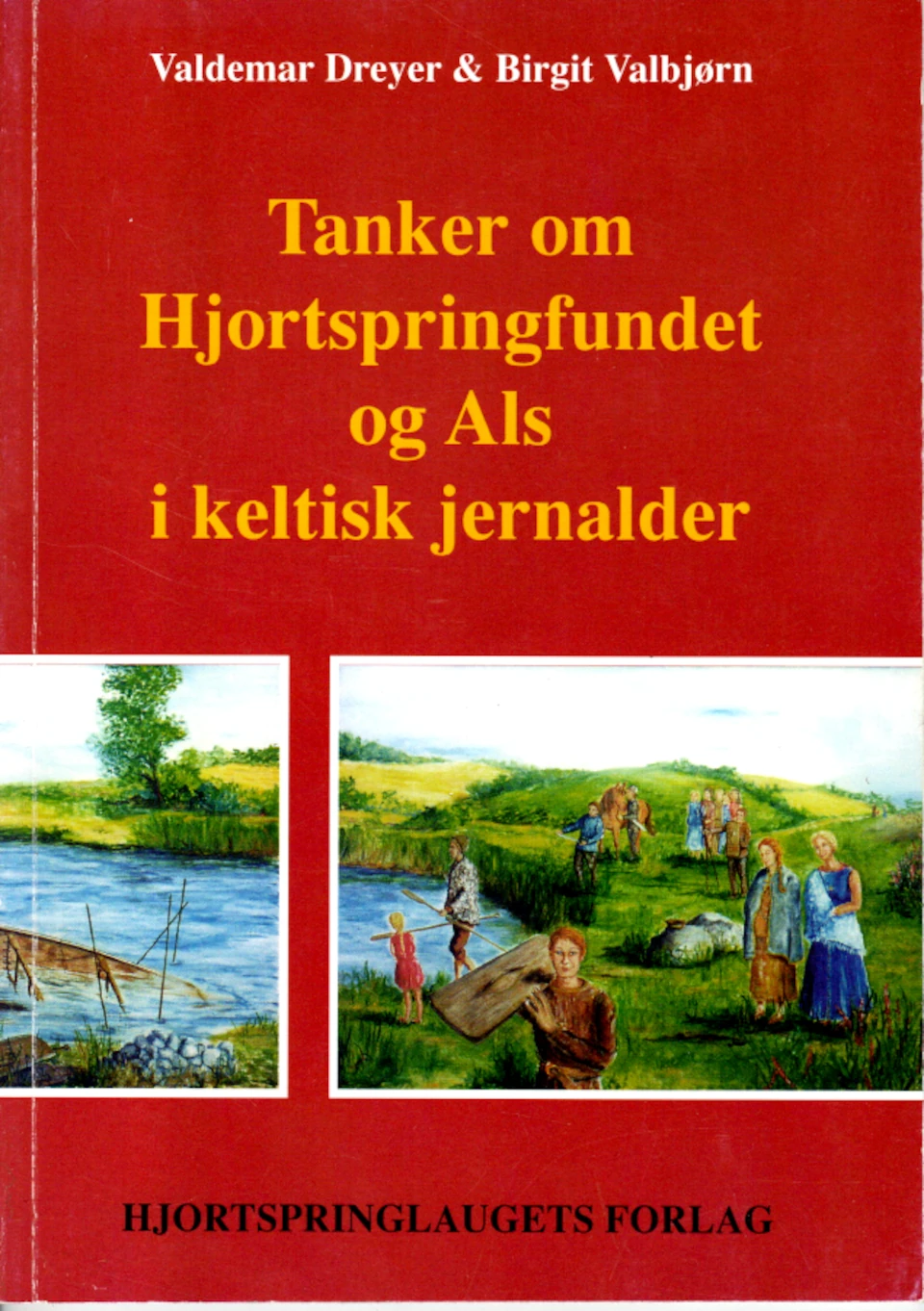On June 5, we met at the Linde shipyard at noon, dressed in our suits. The rain was pouring down. Nevertheless, we rolled the boat out of the yard and got everything ready. People had begun to arrive and soon the first hundred were sheltered inside the hall. A suggestion to wait out the rain was rejected, not least because there was a steady stream of cars heading down towards Dyvig.
We were glad that we had fitted a removable bottom plug so that the boat could be kept empty of water for the two hours it was outside in the pouring rain. One consolation was that the boat had to become increasingly tight as the wood became soaked.
At 14:00, the procession was ready to head down towards Dyvig. The only thing missing was a lure blower team, which, it turned out later, could not arrive due to a queue of cars that stretched over the 3 km to Nordborg.
I At the forefront was the chief with spear, sword and shield. Next came a drummer who beat the beat. Then came the boat, escorted by twenty paddlers in their brightly colored cloaks and peasant's coat. Next came the fifty costumed children from Hjortspring School. Then followed the white-clad goddess Nerthus in her two-wheeled cart, pulled by four slaves. Then twenty white-clad priests chanted their hymn. And finally a few hundred spectators with their brightly colored umbrellas.
1
At Freya's bidding
we go forth,
And likewise
To the praise of Nerthu
we can sing
with all men
a hymn good
with joyful courage.
2
To the Hjortspring Guild
demands are made,
which are now solved
completely without a breach.
We practiced deeds
and built a boat
with a raven flag
for Constitution Day.
3
With sword and shield
in prehistoric times
you were laid down
in the hiding place
as treasure of the gods
in Alsatian night.
It is over.
Now you are free.
Halfway down the road towards Dyvig, we were overtaken by 9 running lurblowers.
When they had formed up at the head of the procession, they started playing their lure melodies.
And it helped. The lurs are interpreted as part of sun worship in the Bronze Age, and sure enough, the rain subsided.
Da vi svingede ind på parkeringspladsen ved Dyvig, mødte os et forbløffende syn.
Tusinder af mennesker stod klar til at bivåne bådens indvielse.As we turned into the parking lot at Dyvig, we were met with an amazing sight.
Thousands of people were ready to witness the inauguration of the boat.
When the boat was in place at the slipway, surrounded by spectators, with the choir of priests lined up, the chief ascended the established rostrum (a discarded stem piece), and spoke:
The boat has asked me to interpret its thoughts, weak as they are in today's language:
I crossed along the shores of the Baltic Sea to the west and north, with a crew of warriors.
I was carried onto the beach at Stevning Nor.
All I know since then is that I was dragged up Stolbro creek, my belly dragging against the rocks.
They put me in a lake and submerged me with stones. I was crushed.
There I lay for millennia, hidden and forgotten. My life seemed over.
In 1885 I was lightly tickled, woke up and lost my stomach.
In 1922, I was awakened and pulled from the bog. I was separated.
In the 1930s I was put together and placed in a dusty room in Copenhagen.
I had been smeared with an unpleasant lotion. I crumbled.
Again I was buried, in a basement, hidden and forgotten.
In 1987, I was brought back to life. What limbs I had left were reassembled,
and I was put into a glass case. Dead or alive. I did not know.
In 1991, I heard that some people wanted to revive me where I had been buried. On Als.
I hardly believed it.
But I was happy and encouraged when the work started and I felt that my life had a new meaning.
I thank the Hjortspring Boat Guild for my new life.
I thank the many members of the construction group, the boat builders, the history group,
the wood and workshop group, those who studied my cargo and gave it life on paper, in wood and in iron.
I thank those who told about me in many meetings, through pictures, signs and speech.
Many in the guild contributed. 20,000 man-hours were probably spent.
I send my thoughts to the active members who perished along the way:
Erik Andersen, Valdemar Dreyer, Jørgen Skawbo and Åge Jensen.
I am grateful for the great support that locals in particular gave my new birth
in the form of gold, silver, work and interest.
I look forward to carrying interested people from my circle of friends around Dyvig later this summer.
I thank the learned men for their knowledge, a knowledge that helped give me back my fair appearance.
Now I am free.
Once again I can greet my old friends, the waves, and fulfill my destiny to sail the Alsatian sea.
Next, various representatives from the surrounding boat guilds took the floor and congratulated Hjortspringbådens Guild on the day and the work.
The founder of modern Danish marine archaeology, civ.ing. Ole Crumlin-Pedersen, took the floor and said:
“The National Museum of Denmark would like to congratulate you on the launch of this magnificent replica of the Hjortspring boat. A huge effort has been made to get this far, a professional-level effort in the face of an extremely demanding reconstruction task.
In the 1930s, after the excavation of the Hjortspring find, the Norwegian marine engineer Fr. Johannessen examined the remains of the boat and drew up the reconstruction drawing, which still holds true in all its main features today, he wrote “Hats off for work like that done in the building of the Hjortspring boat. Even if it were built today, I would say the same - and it is over 2000 years old.”
Now you from the Hjortspring Boat Guild have imitated the masters of the past - and in Johannessen's words I have to say “Hats off for that!” You have continued a tradition of popular involvement in experimental archaeology, which here in the region goes back to T. Hartvig Nielsen's work with “Imme Gram”, and which has developed in commitment and quality to a high point here - with results that have real value for science.
We at the National Museum in Roskilde are delighted to be able to get such a qualified contribution to the study of this unique find - and we look forward to the tests in the late summer.
Our international colleagues are amazed at the excellent results Denmark is producing in the field of experimental ship archaeology. A very significant part of the explanation lies here - in the many talents that come together around such a demanding task and bring the work to such a great result as the one presented today.
Hats off to them.”
After another song from the priest's choir, the boat's crew undressed their jackets, took off their shoes and leg wraps, arranged the carrying straps under the boat and carried it out into the water, flanked by the lur blowers. (They had remembered to put the bottom plug in properly).
The boat was pulled over to the rowing club's floating jetty, which was weighed down to the water level by spectators. After these had been “herded” ashore, a few of the crew boarded and scooped the boat empty. Then the rest of the crew climbed on board and the high priest recited a blessing.
The goddess Nerthus had descended from her cart and with a jar containing sea water, a jar that was a copy of the jar from the Hjortspring find, the goddess baptized the boat:
Oh boat - I bless you and baptize you.
Tilia Alsie is the name you shall bear.
Honor your region and your brave crew,
When with bow and oar you cleave the wave!
We cast off and paddled along the eastern shore of Dyvig so that the thousands of spectators could watch, admire and applaud Tilia with long applause. On the nest was an old Danish yacht with signal flags overhead and a Viking ship, Freja Byrding, a copy of wreck number three from Skuldelev, built in Haderslev.
After a couple of trips, we docked again and a few of the crew were replaced by guests from the National Museum in Roskilde and Copenhagen. Tilia then sailed another trip around the bay. This time we tied up at Freja, where we were presented with a two meter high oak tree. On the way we lost the tree, but a kind motor dinghy picked it up. It is now planted in front of the Linde shipyard.
Once again docked at the floating jetty, the crew disembarked. Tilia was pulled to the slipway, the carrying straps were placed, and Tilia was carried ashore and placed on her trailer. Here, the spectators could see the details of the construction.
The shore of Dyvig in front of the rowing clubs had been transformed into a fairground where guild members demonstrated rope making, woodworking and willow weaving. A barbecue was set up where wild boar was roasted and homemade mead and red wine were served. The latter was the wine of the year in Nordals, donated to the guild by a local sponsor. The label was a drawing of the Hjortspring boat by a local artist.
Around five o'clock the rain started again and the festivities subsided.
Tilia was rolled up to the Linde Yard, dragging a trail of water behind her from the bottom plug hole. This is how she felt her way between Lindeværftet and Dyvig, where she would sail and be tested in the coming years
.
The book:
"Tanker om Hjortspringbåden og Als i keltisk jernalder“ ("Thoughts on the Hjortspring Boat and Als in the Celtic Iron Age”), written by two members of the history group, was introduced and sold in satisfactory numbers already on the first day.




